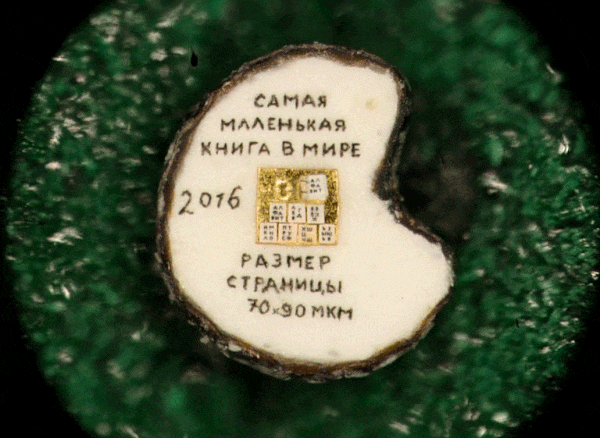This Is the World’s Smallest Book,xxx tv show and Other News
On the Shelf

Vladimir Aniskin’s miniature book, laid out on half a poppyseed. Animation: Vladimir Aniskin
- In the long car ride we call life, Andrew O’Hagan has eschewed the driver’s seat for the passenger seat, and he’s loving every minute of it: “In my natural state, I possess the habit of saying no to everything, but all the requesting party has to do to make me say yes is to send a nice car. In my youth, I often daydreamed of a driver picking me up from school. It was Scotland, and it was winter, which meant it got dark about three o’clock in the afternoon … Being driven is luxurious because it is a step back into the realm of personal freedom, which—when it comes to all areas of good service—is the freedom to enjoy an outcome without being responsible for it. People seek their freedom in different ways, of course, and some want an open top and their own foot on the gas, but for me the liberty to disengage is everything.”
- As if to rebuke all the ambitious young white dudes presently working away at their doorstep debut novels, a Russian scientist named Vladimir Aniskin has designed what he asserts to be the world’s smallest book: it’s seventy by ninety micrometers and takes as its subject, appropriately enough, a flea’s shoes. Readers must exercise extreme care: “The text is printed using the lithographic process onto sheets of film just three or four microns thick. Aniskin said that the most difficult part of the process was binding the pages together so they can be turned. He used tungsten wires with a diameter of five microns as the “springs” for the pages, placing the finished books into half a poppyseed, displayed on gold plates. The pages, which have text on both sides, can be turned using a sharpened metal needle.”
- The line between persecution and a persecution complex can be razor thin. Just ask early Christians, who went to great lengths to highlight their sense of embattlement. Tom Bissell writes: “While some Christians were martyred for their faith, and even thrown to lions, the earliest Christian accounts of martyrdom fail to make clear one interesting wrinkle: killing men and women for perceived apostasy was highly uncommon among pagans, and most ancient-world authorities were inclined to be lenient toward Christians, many of whom, like Ignatius, bishop of Antioch, demandedMartyrdom, then, is a difference-obliterating mind-set that leaves death as the only thing to venerate.”
- Garth Greenwell wrote a forty-one-page paragraph. Not as a standalone, mind you—it’s at the center of his novel What Belongs to You. “I wrote the section very quickly, in a kind of white heat, mostly on the backs of napkins and receipts and other scraps of paper someone might mistake for trash. I numbered these as I wrote and put them in a pile, and it was only when I finished and typed them up that I understood the form of what I had made … [The paragraph] is also a declaration that the text won’t obey the usual rules of logic or sequence, that its allegiance is to other modes of conveying experience. Or maybe less its allegiance than its submission.”
- Today in adaptations of translations: A Brooklyn theater collective has turned John Ashbery’s translations of Rimbaud into Rimbaud in New York, a play designed never to let you forget that it’s rooted in text: “The play is about myths, to be sure, but it’s also concerned with the pleasure of the text and emotions and thoughts that words can and cannot illuminate. Ashbery not only captures that French renegade’s intensity and playfulness in his translation, he does so with an urgency that reminds us that Rimbaud left the form that he helped create—modernism—as a disenchanted young man, while Ashbery, never a cynic, works in his own vibrant space, one that goes on and on.”


